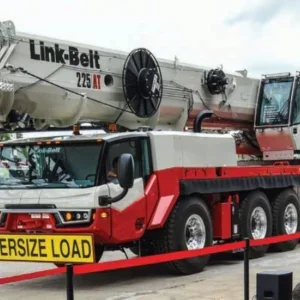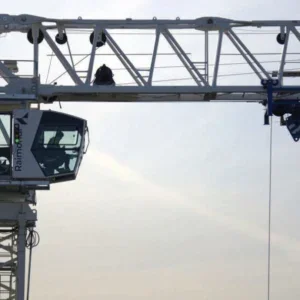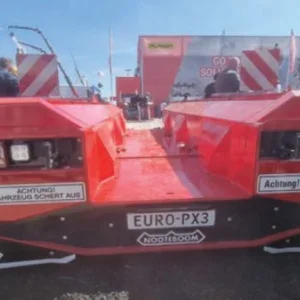Milan, Italy
Campo Tures-based contractor ZH GCC used five Terex tower cranes to build two residential tower at Porto Nuova, in the Isola district of Milan. The cranes were in operation for almost three years.
The four CTT181B-8 TS 21s and one CTT331-16 TS23 are being used to lift materials on the site. The layout of the cranes proved a particular challenge, as one of the cranes, the CTT331, had to be erected through the lift shaft of a garage between the two towers, far from the main buildings. As the towers were built the crane needed to be erected to a final height of 140m, it was first tied in using stays reaching 14m and then, when this was not possible, using a specially-engineered guyed collar section tied to both towers.
Two of the CTT181B-8 tower cranes were custom fitted with a shorter jib of 30m.
Vila Real, Portugal
Ibergru has supplied two Linden Comansa tower cranes to CAET XXI, the temporary consortium building a viaduct over the river Corgo in Vila Real, Portugal. The viaduct, one of the longest and highest in Portugal, is part of the Transmontana Highway, which will soon link the city of Oporto to the Spanish border.
The Corgo Viaduct, with a length of 2,795m, a height from the bottom of the valley of 230m, and a main span of 300m, will run over three roads and one railway line. Pillars number 18 and 19, the highest of the whole structure, are being built by two 18t Linden Comansa 21 LC 400 flat top cranes erected with jib lengths of 70m, able to lift 5t at the jib-end. They are working at heights up to 207m.
Ibergru used a J4-1 hydraulic cage to jack the cranes up from 69.2m to 207m in four stages. Each crane is tied to its pillar in four places, with a length from the crane’s mast to the viaduct’s pillar of up to 10m.
Installing tie frames has also been executed by Ibergru. According to the company’s technical director, António Fonseca, its installation has demanded a strong coordination with the works in progress: "The metal sheets for the ties were set on each pillar by night during the sliding of the formwork, allowing the sheets to be placed in merely three hours."
Carcassonne, France
French crane operator Hugon used a compact Liebherr LTC 1045-3.1 to install a 2t air conditioning unit on a hotel roof within the ancient walled town of Carcassone. To get to the job site, the crane had to be small enough to pass throught the low medieval gateway into the old part of the town.
The 45t compact crane is only 3m high when on the move, and has extremely small turning radii. The load only weighed 2t, but the area for setting up the crane was so restricted that the support base had to be drastically reduced. This meant that the actual assembly of the air-conditioning unit was actually the easiest part of this difficult and demanding project.
Hugon have been Liebherr customers since 1980, and during that time have purchased 50 Liebherr telescopic cranes. The crane fleet consist at present of 27 mobile cranes, 26 of them being Liebherr units. The largest is the 350-tonner LTM 1350-6.1. As well as crane hire, Hugon also specialize in working platforms and heavy haulage transports.
Salerno, Italy
Three Potain tower cranes will spend the next three years working in strong winds and sea air at the ‘Front of the Sea’ development in Salerno, southern Italy. The cranes, which were erected earlier this year, are lifting a variety of construction materials and equipment to build a seven-story crescent shaped building that will define a new landscape for the city’s port.
The three cranes are 12t capacity MD 310 C K12s, two of which are owned by RCM Costruzioni Spa and the other by Ritonnaro Costruzioni Spa. The two main contractors are working together in a joint venture on the project.
The cranes are working up to eight hours a day, six days a week. They are responsible for a range of activities including ground preparation work and lifting 10t reinforced concrete slabs that will make up the structure of the modular-designed building.
Two of the cranes are working at hook heights of 36m and the third crane operates at a height of 46m. All of the cranes are configured with 55m jibs and provide complete coverage of the site. The first crane was erected in April with the second and third added in May and June respectively.
Gebze, Turkey
Turkish steel producer Colakoglu Metalurji is using a Sennebogen 6200 HCC at the port of Çolakoglu in Gebze to lift scrap and finished steel products.
Supplies need to be constantly replenished for continuous operation at the plant and many tons of steel products leave every day. The plant’s own port is a major hub in this process. Scrap is delivered to the steel plant by water and in trucks. A large proportion of the finished steel is then transported on by ship. Around 4,000USt of scrap and 10,000USt of steel rolls have to be loaded onto and unloaded from the waiting ships.
Construction steel and slabs are lifted and positioned on the ships in bundles of up to 30t. Equipped with a 2x 200kN heavy-load winch and rigid wide gauge undercarriage, the Sennebogen 6200 HCC is ideally suited to the challenging tasks at the port.
Thanks to the powerful electric motor, the machine is not only environmentally-friendly and economical to run, but is also highly efficient.






